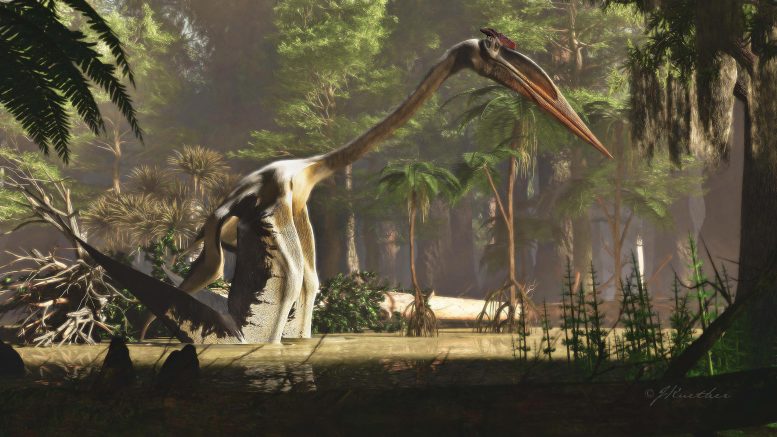
An artist’s rendition of Quetzalcoatlus northropi, a type of pterosaur and the largest flying animal that ever lived on Earth. Quetzalcoatlus stood about 12 feet tall and walked with a unique gait because of its enormous 20-foot wings, which touched the ground when folded. Credit: Artwork courtesy of James Kuether
70 million-year-old fossils reveal unique walking behavior of this huge, heron-like pterosaur.
Look around any wetland today and you’re likely to see 3-foot-tall egrets or 4-foot-tall herons wading in the shallows in stealthy search of fish, insects or crustaceans.
But 70 million years ago, along the Rio Grande River in Texas, a more impressive and scarier creature stalked the marshes: the 12-foot-tall pterosaur known as Quetzalcoatlus. With a 37- to 40-foot wingspan, it was the largest flying animal that ever lived on Earth.
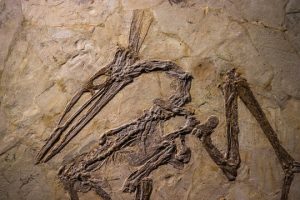
In six papers published this week as a Memoir by the Society of Vertebrate Paleontology, scientists and an artist provide the most complete picture yet of this dinosaur relative, the largest example of which is represented by just a single set of fossilized bones collected in the late 1970s from Big Bend National Park. The papers describe the pterosaur’s geological and ecological setting during the Upper Cretaceous, its anatomy and taxonomic position, and how it moved on the ground and in the air.
One of the papers, co-authored by University of California, Berkeley, paleontologist Kevin Padian, emeritus professor of integrative biology and emeritus curator in the UC Museum of Paleontology, answers some of the mysteries surrounding the flying and walking behavior of this unique animal, about which little has been published since its discovery more than 45 years ago. How can an animal walk with wings so long that they touch the ground when folded? What did it eat, and how did it feed? How strong a flier was it? And how does an animal whose wings span 40 feet, yet whose legs are only 6 feet high at the hip, launch itself into the air?
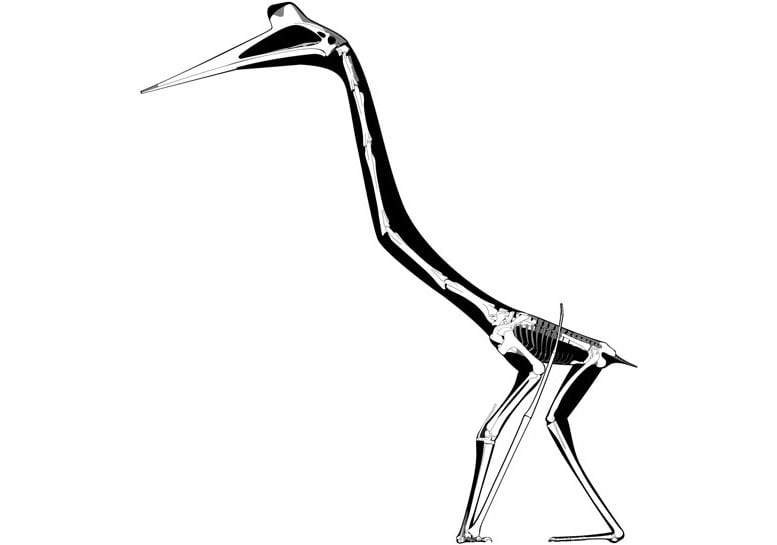
A sketch of the bones of Quetzalcoatlus northropi. When walking, the animal had a unique gait unlike any other, and distinctly different from that of the vampire bat. Credit: Drawing by John Conway
“This ancient flying reptile is legendary, although most of the public conception of the animal is artistic, not scientific,” said Padian, who co-edited the monograph. “This is the first real look at the entirety of the largest animal ever to fly, as far as we know. The results are revolutionary for the study of pterosaurs — the first animals, after insects, ever to evolve powered flight.”

The original Quetzalcoatlus fossils were discovered by Douglas Lawson, who at the time was a 22-year-old studying for a master’s degree in geology at the University of Texas, Austin, and later became a doctoral student at UC Berkeley. The fossil pterosaur — which he named after the Aztec flying serpent god — consisted of a partial wing that implied a size comparable to that of some airplanes and was at least 50% bigger than the wings of the largest known bird, an extinct and much larger relative of living condors and a descendent of the dinosaurs.
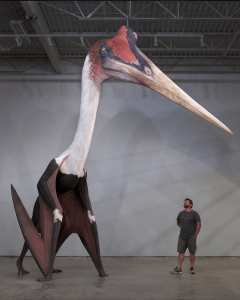
Unlike the serpent god, Quetzalcoatlus had no feathers: Its body, including wings of skin and fibers of keratin, was covered with hair, as in all pterosaurs. Like dinosaurs, it was likely warm- blooded and active. It had lost its tail, presumably to improve its maneuverability, and its 6-foot neck and 4-foot crested skull suggest a stork on steroids.
Wann Langston, for many years a curator of UT Austin’s Vertebrate Paleontology Laboratory, invited many colleagues, including Padian, to work on the fossils, but was unable to publish a full description of the animal before his death in 2013.
At the request of the laboratory, Padian teamed up with engineer and amateur paleontologist James Cunningham and London artist John Conway — all longtime colleagues of Langston — to look at the fossilized bones of Lawson’s find, Quetzalcoatlus northropi, and compare them with more numerous specimens of a smaller Quetzalcoatlus species in order to better understand feeding, flying, walking and launch behavior. Langston is listed as a fourth co-author of the paper.
“Jim and John and I came to the project with very different ideas,” Padian said, “but we didn’t put a single statement in our paper unless all three of us agreed on it.”
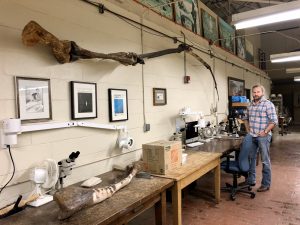
Playing with the bones
To understand how the Quetzalcoatlus pterosaurs behaved, Padian and colleagues manipulated casts of bones from about a dozen smaller and more complete pterosaur fossil skeletons, including those of the species Quetzalcoatlus lawsoni, which is newly-named after Lawson in one of the accompanying papers. The Q. lawsoni fossils were found in the same Javelina Formation in West Texas around the time the larger Q. northropi was excavated. The smaller specimens are half the size of the larger one Lawson initially found, but they consist of about 300 fossilized bone bits. The larger animal, however, is known only from a few wing bones: a humerus and an ulna from the upper arm and forearm, respectively.
The picture that Padian, Cunningham and Conway paint is of an animal similar to egrets and herons in how it feeds and launches itself into the air, like condors and vultures in how it soars, but, because of its enormous wings, unlike any other known animal in how it walks.
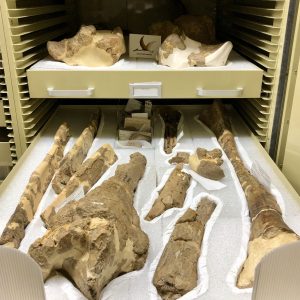
“Pterosaurs have huge breastbones, which is where the flight muscles attach, so there is no doubt that they were terrific fliers,” he said. “Their upper arm bone — the humerus — has huge, bony crests for anchoring the flight muscles, which are larger than those of birds and far larger than those of bats. The wings worked essentially like those of birds and other dinosaurs, to which pterosaurs are most closely related. Despite two centuries of reconstructing pterosaurs like bats, there is no evidence for this view: Bats are unique and very different from birds and pterosaurs.”
Like birds and bats and even humans, the forelimbs of pterosaurs have three segments: the upper arm or humerus, from the shoulder socket to the elbow; the forearm, including the radius and ulna; and the wrist and hand bones. But unlike birds and bats, the leading edge of the outer part of the pterosaur wing is formed by a giant wing-finger.

“It’s like having a ski pole extended from the base of your fingers and angled 90 degrees outward,” Padian said.
Quetzalcoatlus was bipedal, that is, it walked on two legs. But because its forelimb bones are so elongated, its wings could not avoid touching the ground when folded. This four-point stance suggested to some that the pterosaurs walked like a vampire bat, which uses its forelimbs to propel itself forward on the ground. But study of the bones shows that the pterosaur could not have used the wings for propulsion. When grounded, they could only move their wings forward or to the side.
“Once you put the forelimbs on the ground in these pterodactyls, you can’t rotate the forelimb back to push the animal forward like any sensible quadruped because there’s a bone in the way in the shoulder,” Padian said.
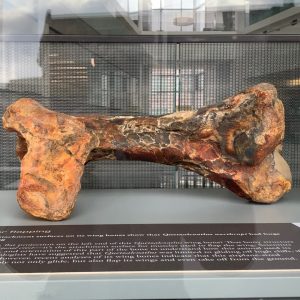
That doesn’t mean they were clumsy.
“To avoid tripping, the animal first raised its left arm, then advanced its left leg in a full step, then it placed the hand on the ground,” he said. “The process was repeated with the right limb: The right arm lifted, the right leg advanced and emplaced the right foot, and then the right hand descended. It seems a cumbersome process to us, but the animal could execute the gait quickly and easily.”
This fits perfectly with trackways of walking pterosaurs discovered in Southern France in the 1990s, Padian said.





